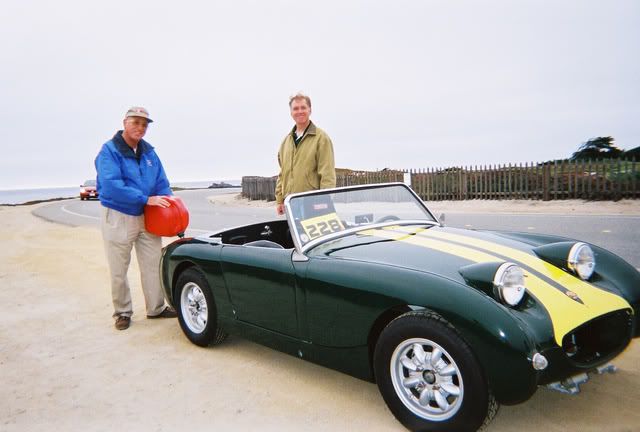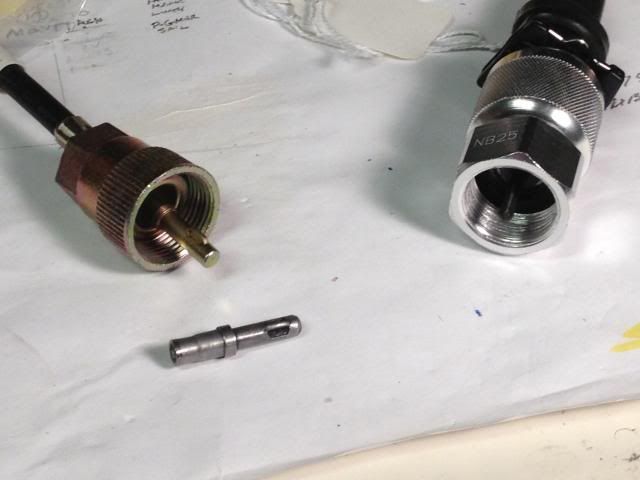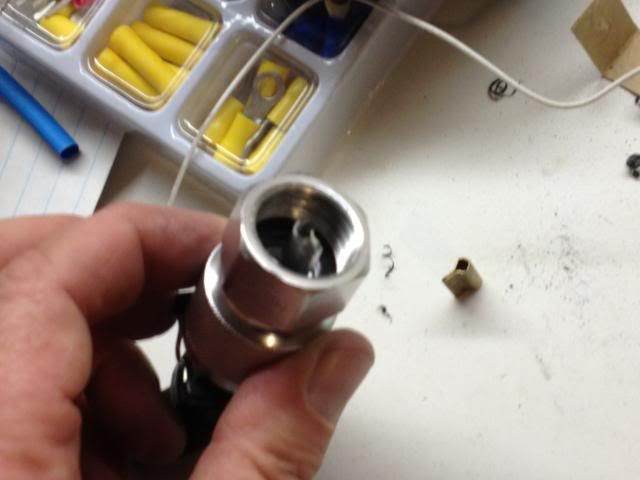johntennyson
Senior Member
Offline
I'm feeling pretty chuffed right now as I've been able to make an electric speedo work in my Sprite. When I re-restored it ten years ago, I went to the Rivergate 5-speed conversion which uses a Nissan 210 gearbox. I didn't like the option to use the mechanical conversion for the stock gauge, so I went without a speedometer--or a fuel gauge-- for a long time, which led to episodes like this...

...when I ran it out of gas on the Pacific Grove funky old car tour. After a good experience with an electric speedo in another project car, I ordered a speedometer from Speedhut and their sending unit for GM transmissions. It looked like I might be able to somehow make it work, if not directly in the Nissan trans, then from the end of the speedometer cable. Maybe.
It turned out that the thread spec of the receptacle on the Nissan trans is the same as the GM or Chrysler. Thank you, SAE or whoever!
The only problem is that the rotating core of the GM sender is a 3mm square-section bit and the rotating end of the Nissan cable is ~4mm round with a tab swaged into it to fit into a slot in the receptacle.

Even Palo Alto Speedometer wasn't sure what to do. I wound up making a mandrill to duplicate the core of the GM sender by filing a 3mm nail into a square section and taking a 3/4" long section of 1/4" brass tubing and squeezing it around the mandrill with pliers to get a square section with a tab. It fit both the sender and the trans and engaged the slot in the trans receptacle.

I later made one out of stainless steel and stuck the works in the car. In the picture, the brass one is on the right, the stainless one is installed in the sending unit.
It works! The biggest problem I had was with the gauge mounting ring. The gauge itself is remarkably shallow and is held in place by a large plastic ring which threads onto the gauge body. On my gauge's mounting ring, the threads weren't cut all the way to the end of the ring and it jammed a few mm short of secure and it was a shouting obscenities PITA to get back off. I cleaned up the threads by hand and when they were still really tight, loosened them up enough by running a scouring pad over them. If you use one of their gauges, make sure the mounting ring will screw all the way down cleanly BEFORE sticking it in the dash. Other than that, it works and looks great. The great thing about Speedhut is that all their gauges are custom jobs, with a lot of appearance, size and function options. You can even upload graphics to their site and they'll put them on the gauge, which is how I got the Austin-Healey script on mine. Maybe I should have sent them the "British Leyland Special Tuning" emblem... Hmmmm...

The only problem now is that I have no excuse for running out of gas again!

...when I ran it out of gas on the Pacific Grove funky old car tour. After a good experience with an electric speedo in another project car, I ordered a speedometer from Speedhut and their sending unit for GM transmissions. It looked like I might be able to somehow make it work, if not directly in the Nissan trans, then from the end of the speedometer cable. Maybe.
It turned out that the thread spec of the receptacle on the Nissan trans is the same as the GM or Chrysler. Thank you, SAE or whoever!
The only problem is that the rotating core of the GM sender is a 3mm square-section bit and the rotating end of the Nissan cable is ~4mm round with a tab swaged into it to fit into a slot in the receptacle.

Even Palo Alto Speedometer wasn't sure what to do. I wound up making a mandrill to duplicate the core of the GM sender by filing a 3mm nail into a square section and taking a 3/4" long section of 1/4" brass tubing and squeezing it around the mandrill with pliers to get a square section with a tab. It fit both the sender and the trans and engaged the slot in the trans receptacle.

I later made one out of stainless steel and stuck the works in the car. In the picture, the brass one is on the right, the stainless one is installed in the sending unit.
It works! The biggest problem I had was with the gauge mounting ring. The gauge itself is remarkably shallow and is held in place by a large plastic ring which threads onto the gauge body. On my gauge's mounting ring, the threads weren't cut all the way to the end of the ring and it jammed a few mm short of secure and it was a shouting obscenities PITA to get back off. I cleaned up the threads by hand and when they were still really tight, loosened them up enough by running a scouring pad over them. If you use one of their gauges, make sure the mounting ring will screw all the way down cleanly BEFORE sticking it in the dash. Other than that, it works and looks great. The great thing about Speedhut is that all their gauges are custom jobs, with a lot of appearance, size and function options. You can even upload graphics to their site and they'll put them on the gauge, which is how I got the Austin-Healey script on mine. Maybe I should have sent them the "British Leyland Special Tuning" emblem... Hmmmm...

The only problem now is that I have no excuse for running out of gas again!

 Hi Guest!
Hi Guest!

 smilie in place of the real @
smilie in place of the real @
 Pretty Please - add it to our Events forum(s) and add to the calendar! >>
Pretty Please - add it to our Events forum(s) and add to the calendar! >> 
